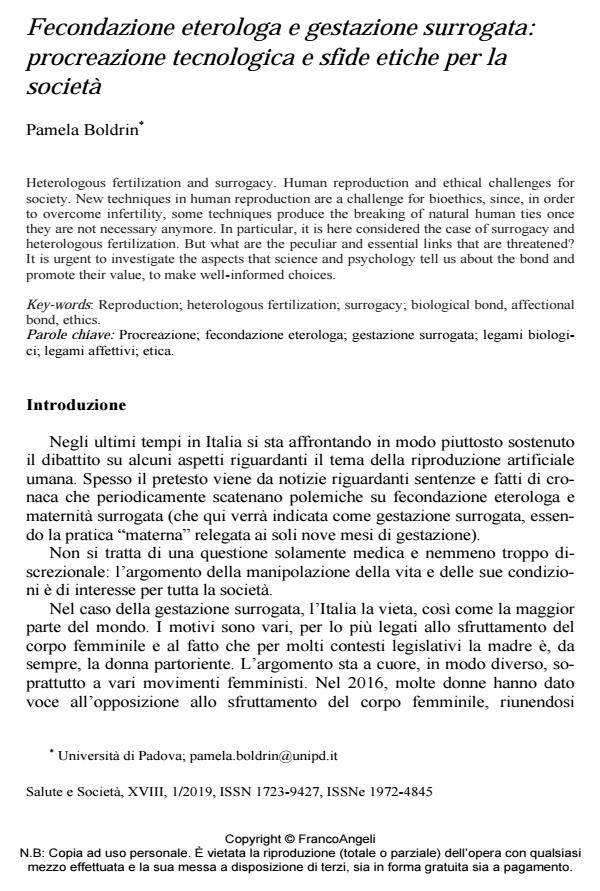Fecondazione eterologa e gestazione surrogata: procreazione tecnologica e sfide etiche per la società
Titolo Rivista SALUTE E SOCIETÀ
Autori/Curatori Pamela Boldrin
Anno di pubblicazione 2019 Fascicolo 2019/1 Lingua Italiano
Numero pagine 14 P. 150-163 Dimensione file 211 KB
DOI 10.3280/SES2019-001010
Il DOI è il codice a barre della proprietà intellettuale: per saperne di più
clicca qui
Qui sotto puoi vedere in anteprima la prima pagina di questo articolo.
Se questo articolo ti interessa, lo puoi acquistare (e scaricare in formato pdf) seguendo le facili indicazioni per acquistare il download credit. Acquista Download Credits per scaricare questo Articolo in formato PDF

FrancoAngeli è membro della Publishers International Linking Association, Inc (PILA)associazione indipendente e non profit per facilitare (attraverso i servizi tecnologici implementati da CrossRef.org) l’accesso degli studiosi ai contenuti digitali nelle pubblicazioni professionali e scientifiche
Heterologous fertilization and surrogacy. Human reproduction and ethical challenges for society. New techniques in human reproduction are a challenge for bioethics, since, in order to overcome infertility, some techniques produce the breaking of natural human ties once they are not necessary anymore. In particular, it is here considered the case of surrogacy and heterologous fertilization. But what are the peculiar and essential links that are threatened? It is urgent to investigate the aspects that science and psychology tell us about the bond and promote their value, to make well-informed choices.;
Keywords:Procreazione; fecondazione eterologa; gestazione surrogata; legami biologici; legami affettivi; etica.
- Bydlowski M. (2000). Je rệve un enfant. L’experience interiore de la maternité. Paris: Odile Jacob. (trad. it.: Sognare un figlio. Bologna: Edizioni Pendragon, 2004).
- Bergman K., Sarkar P., O’Connor T.G., Modi N., Glover V. (2007). Maternal Stress During Pregnancy Predicts Cognitive Ability and Fearfulness in Infancy. NJ. AM. Acad. Child Adolesc. Pschiatry, 46:11: 1454-1463.
- Boldrin P. (2017). Cervello di mamma. http://www.scienzainrete.it/articolo/cervello-di-mamma/pamela-boldrin/2017-03-17
- Brazelton T.B., Sparrow J. (2006). Touchpoints: Birth to Three: Your Child’s Emotional and Behavioral Development. 2nd rev. ed. Cambridge, MA.: Perseus Publishing (Trad. it: Il bambino da 0 a 3 anni. Milano: Rizzoli, 2008).
- Cooper M., Waldby C. (2014). Clinical Labor: Tissue Donors and Research Subjects in the Global Bioeconomy. Durham: Duke University Press (trad. it: Biolavoro globale. Corpi e nuova manodopera. Roma: DeriveApprodi, 2015),
- Cranley M. (1981). Development of a tool for the measurement of maternal attachment during pregnancy. Nursing Research, 30: 281-84. DOI: 10.1097/00006199-198109000-0000
- Danna D. (2017). «Fare un figlio per altri e giusto» Falso! Roma: Laterza.
- Gallese V., Ammaniti M. (2014). La nascita dell’intersoggettività. Lo sviluppo del sé tra psicodinamica e neurobiologia. Milano: Raffaello Cortina Editore.
- Hartocollis A. (2014). And surrogacy makes three, in New York times -- http://www.nytimes.com/2014/02/20/fashion/In-New-York-Some-Couples-Push-for-Legalization-of-Compensated-Surrogacy.html?_r=0
- Jonas H. (2002). Il principio responsabilità. Un’etica per la civiltà tecnologica. Milano: Biblioteca Einaudi.
- Klopfenstein D. (1993). Study of bone vibration transmission on the child’s head in utero. Rev Fr Gynecol Obstet.: 88(1): 39-44.
- Levine A., Weller A., Zagoory-Sharon O., Feldman R. (2007). Evidence for a Neuroendocrinological Foundation of Human Affiliation. PsycholSci, 18 (11): 965-70.
- Marchi S. (2017). Mio tuo suo loro. Donne che partoriscono per altri. Roma: Fandango.
- Medawar P.B. (1953). Some immunological and endocrinological problems raised by the evolution of viviparity in vertebrates. Symp. Soc. Exp. Biol., 44: 320-338.
- Muraro L. (2016). L’anima del corpo. Contro l’utero in affitto. Milano: La Scuola.
- Paul Murphy A. (2010). How the nine months shape the rest of our life, New York: Simon and Schuster (trad. it: I nove mesi decisivi. Milano: Tecniche Nuove Edizioni, 2012).
- Sama: Resource Group for Women and Health. (2010) Constructing conceptions: the mapping of assisted reproductive technologies in India. New Delhi.
- Sama: Resource Group for Women and Health (2012). Birthing a market: a study on commercial surrogacy, New Delhi.
- Samama E. (2011). Embryo Carrying Agreement (Surrogacy): vision, policy, and reality. Doctoral dissertation, Department for Health System Management, Ben Gurion Univerity of the Negev.
- Varendi H., Porter R.H., Winberg J. (1996). Attractiveness of amniotic fluid odor: evidence of prenatal olfactory learning? Acta Paediatrica, 85: 1223-1227.
- Winnicott D.W. (1956). Primary Maternal Preoccupation. Collected Papers: Through Paediatrics to Psycho-Analysis. London: Tavistock, 1958. (trad. it: La preoccupazione materna primaria. In: Dalla pediatria alla psicoanalisi, Firenze: Martinelli, 1973).
Pamela Boldrin, Fecondazione eterologa e gestazione surrogata: procreazione tecnologica e sfide etiche per la società in "SALUTE E SOCIETÀ" 1/2019, pp 150-163, DOI: 10.3280/SES2019-001010